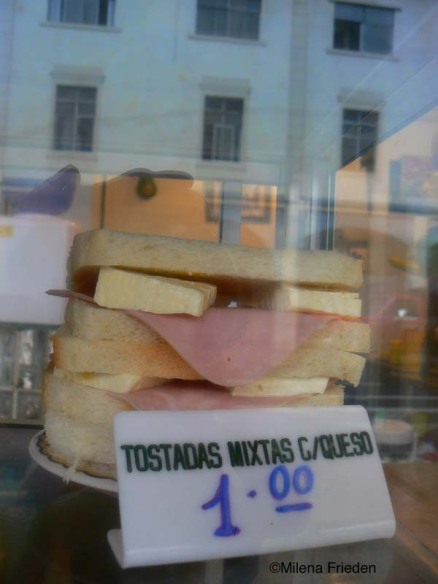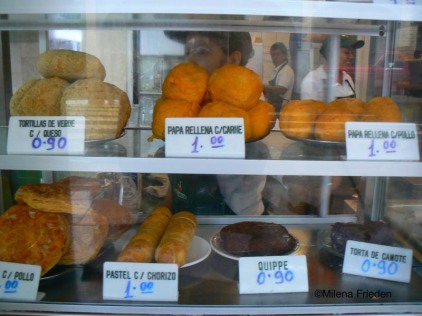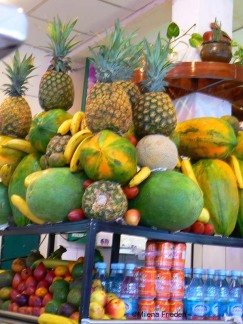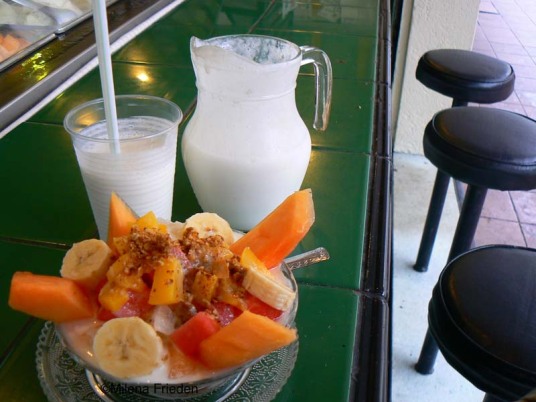It is a grey overcast, but warm and bright Saturday. A few days ago, I returned from a very enjoyable month-long trip visiting family and friends. My return flights were pleasant and I arrived to a warm welcome (people and weather) in Guayaquil. It is nice to be back in Ecuador.
I am sitting at the dark green tiled countertop of Las 3 Canastas (The 3 Baskets) at the corner of Chile and Velez in Guayaquil. Fresh cheese and ham sandwiches piled on small plates sit on top of one of the stainless steel shelves in the glass case in front of me. The rest of the shelves and countertop are lined with small silver platters or white plates stacked with bolón de verdes (balls of mashed plantains mixed with cheese), humitas (corn tamales), papas rellenas (balls of fried mashed potatoes stuffed with meat or chicken), tortillas de verde (mashed plantains filled with cheese), pastel de pollo or chorizo (puff pastry with chicken or pork sausage), quippe (could not find a translation, but am curious to know what it is) and torta de camote (sweet potato cake). Another glass case protects and displays a rich assortment of colorful fruits (cantaloupe, pineapple, peaches, papaya, strawberries, raspberries, watermelon and bananas). There are more fruits (apples, grapefruits, persimmons and tomato de arbol) stacked on layers of black shelves behind the register.
There are also fruits hidden from view, because I just ordered my favorite shake, guanabana, and don’t see the guanabanas. Once ripe, guanabanas deteriorate quickly, so they are probably stored in the refrigerator. Although guanabana is my favorite, I have tried many other fruit shakes, including mamey, naranjilla and mango. All are delicious.
Guanabanas (Annona muricata) are large pocked green fruits, typical characteristics of the cherimoya species and custard apple family to which they belong. Inside they contain black pea-sized seeds and a white custard-like cream. In other parts of the world they are also known as guyabano or soursop. Mamey (Pouteria sapota) is especially common in Mexico, Central America and the northern part of South America. It has a smooth beige brown skin and is a deep orangish red inside. Mamey’s taste reminds me of raspberries. The first time I tried it was six and a half years ago at a small roadside stand in Acapulco. It was my first trip to Latin America.
The naranjilla (Solanum quitoense) has a reddish orange skin and resembles a greenish yellow tomato on the inside. It is a member of the tomato family. Quitoense refers to Quito, the capital of Ecuador. Though not one of my favorites, tomate de arbol juice is also quite popular in Ecuador. The egg-shaped tomate de arbol (Solanum betaceum) is also a member of the tomato family and comes in yellow and red.
Accompanying my guanabana shake is a small bowl of mixed fruit (cantaloupe, pineapple, watermelon, banana, papaya and peaches)) with yogurt and granola topped with a little brown sugar. In some parts, honey is used instead. This is my breakfast. It is absolutely delicious and all for $3.90.
Earlier, the line at Las 3 Canastas was especially long. The streets of Guayaquil are filled with thousands of people, including many out-of-towners. All ages and ethnic backgrounds from various regions of Ecuador are represented. They are gathering to demonstrate their allegiance to the president, Rafael Correa. More specifically, they are rallying and drumming up support for their president in the city of Guayaquil. This industrial port is Ecuador’s largest city with approximately 2,200,000 inhabitants. Guayaquil’s mayor is Jaime Nebot, a prominent Ecuadorian affiliated with one of the president’s opposing parties.
Voted into office on 6 December, 2006, Rafael Correa is the 56th Ecuadorian president and the seventh president Ecuador has seen in the past eleven years. The president belongs to the left-wing Christian party, Aliaza PAIS. PAIS means country and is also the acronym for Patria Altiva I Soberana, which translates to Proud and Sovereign Fatherland. Jaime Nebot has been mayor of Guayaquil since 2000 and is a member of the Partido Social Cristiano, the center-right Social Christian Party.
My hotel is in the center of town on one of the main streets, 9 de Octubre. This morning, I awoke at 7am to lively music and people sporadically raising their voices. When I looked out the window I was surprised to see only a few people on the street. Stages were setup alongside the road with enormous speakers reverberating a series of lively tunes. It was not long before the amount of people matched the noise level. Soon, speeches, parades and performances were in full swing. There was also a parade on Victor Manuel Rendon, the street parallel to 9 de Octubre.
By 9am, the downtown was teeming with people in lime green t-shirts reading, “35 PAIS, Patria Altiva I Soberana, Asamblea es Pais!” The number thirty-five represents Alianza PAIS, the president’s party. Other popular t-shirts are white with light blue writing, “Guayaquil apoya Correa, La Revolución Ciudadana Cumple un Año,” (Guayaquil supports Correa, the revolutionary citizens have one year behind them) and yellow t-shirts with black lettering emphatically stating, “Todos contra La Corrupción!,” which translates to “Everyone against Corruption!” Of course, on any given day, there are people sporting the Guayaquil Barcelona soccer team’s bright yellow t-shirts listing the team’s sponsors Banco Pichincha and Pilsener.
The indigenous Andean women wear long bright pink, green or blue skirts and neatly pressed white blouses. Countless strands of gold necklaces adorn their necks. The women wear brown or black loafers or black cloth sandals. Most indigenous men and women wear a dark felt hat. Men, women and children mill around eating plates of choclo (large-grained corn), pork and/or fruit. I walk by a large pile of small plastic bags filled with All Natural water, available free of charge for passersby. Almost every block is lined with a combination of uniformed members of the civil defense, military and national police. In some areas, there is a greater concentration of the latter two. It is a lively crowd and people are enjoying the opportunity to congregate and be entertained.










I came across your blog after seeing that someone had linked to mine through yours. I haven’t read all the entries yet, but so far it is an extremely enjoyable textual/photographic exploration. Your interwoven photos and descriptions of misc. observations and encounters bring fond memories of South America, which I haven’t visited for a few years. I realize that it’s time to go back.
Have you found Lucuma in the markets?… another fantastic semi-highland fruit closely related to both Mamey and Caimito. Another one I used to find in Quito and thereabouts is Pitaya, or Dragon Fruit, born on a cactus, incredible flavor. There are pink and yellow varieties.
Thanks for your comments. It is nice to hear that my blog inspires you to return to South America. As you know, there are so many wonderful things to see and do there. I very much enjoyed reading the plant information and seeing the photos on your blog, http://anthrome.wordpress.com.
To my knowledge, I haven’t seen Lucuma in the markets. Perhaps, it was there, but I wasn’t aware of it. Pitajaya, Hylocereus polyrhizus, really is delicious and I plan to write about it soon. I have a number of Pitajaya photos taken in the wild.
I’m living in Guayaquil, and I noticed you mentioned “quippe” and didn’t know what they are. This is a local version of the Arabic “kibbeh,” in this case fried teardrop-shaped balls of bulgur wheat dough with a spiced ground meat filling. They are served with a garlic sauce. One of my favorite snack bar foods here!
Dear Patricia,
Thanks so much for your explanation of “quippe.” I must admit, they did not immediately appeal to me, but they sound delicious and I will try them next time I am on the Ecuadorian coast.
Saludos,
Milena